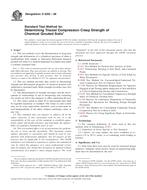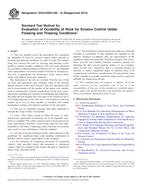Potřebujeme váš souhlas k využití jednotlivých dat, aby se vám mimo jiné mohly ukazovat informace týkající se vašich zájmů. Souhlas udělíte kliknutím na tlačítko „OK“.
ASTM D4452-14
Standard Practice for X-Ray Radiography of Soil Samples
Automaticky přeložený název:
Standardní praktiky pro X-Ray rentgenu půdních vzorků
NORMA vydána dne 1.7.2014
Informace o normě:
Označení normy: ASTM D4452-14
Poznámka: NEPLATNÁ
Datum vydání normy: 1.7.2014
Kód zboží: NS-27290
Počet stran: 14
Přibližná hmotnost: 42 g (0.09 liber)
Země: Americká technická norma
Kategorie: Technické normy ASTM
Kategorie - podobné normy:
Zemní práce. Hloubicí práce. Budování základů. Podzemní práce
Anotace textu normy ASTM D4452-14 :
Keywords:
intact samples, sample disturbance, samples, soil investigations, X-rays, ICS Number Code 93.020 (Earth works. Excavations. Foundation construction. Underground works)
Doplňující informace
| Significance and Use | ||||||||
|
4.1 Many geotechnical tests require the utilization of intact, representative samples of soil deposits. The quality of these samples depends on many factors. Many of the samples obtained by intact sampling methods have inherent anomalies. Sampling procedures cause disturbances of varying types and intensities. These anomalies and disturbances, however, are not always readily detectable by visual inspection of the intact samples before or after testing. Often test results would be enhanced if the presence and the extent of these anomalies and disturbances are known before testing or before destruction of the sample by testing. Such determinations assist the user in detecting flaws in sampling methods, the presence of natural or induced shear planes, and the presence of natural intrusions, such as gravels or shells at critical regions in the samples, the presence of sand and silt seams, and the intensity of some of the unavoidable disturbances caused by sampling. 4.2 X-ray radiography provides the user with a picture of the internal massive structure of the soil sample, regardless of whether the soil is X-rayed within or without the sampling tube. X-ray radiography assists the user in identifying the following: 4.2.1 Appropriateness of sampling methods used, 4.2.2 Effects of sampling in terms of the disturbances caused by the turning of the edges of various thin layers in varved soils, large disturbances caused in soft soils, shear planes induced by sampling, or extrusion, or both, effects of overdriving of samplers, the presence of cuttings in sampling tubes, or the effects of using bent, corroded, or nonstandard tubes for sampling, 4.2.3 Naturally occurring fissures, shear planes, and the like, 4.2.4 The presence of intrusions within the sample, such as calcareous nodules, gravel, or shells, and 4.2.5 Sand and silt seams, organic matter, large voids, and channels developed by natural or artificial leaching of soils components. Note 1: The quality of the results produced by this standard
is dependent on the competence of the personnel performing it, and
the suitability of the equipment and facilities used. Agencies that
meet the criteria of Practice D3740 are generally considered capable of
competent and objective testing/sampling/inspection/and the like.
Users of this method are cautioned that compliance with Practice
D3740 does not in itself
ensure reliable testing. Reliable testing depends on many factors;
Practice D3740 provides a
means of evaluating some of those factors.
|
||||||||
| 1. Scope | ||||||||
|
1.1 This practice covers the determination of the quality of soil samples in thin wall tubes or of extruded cores by X-ray radiography. 1.2 This practice enables the user to determine the effects of sampling and natural variations within samples as identified by the extent of the relative penetration of X-rays through soil samples. 1.3 This practice can be used to X-ray cores (or observe their features on a fluoroscope) in thin wall tubes or liners ranging from approximately 50 to 150 mm (2 to 6 in.) in diameter. X-rays of samples in the larger diameter tubes provide a radiograph of major features of soils and disturbances, such as large scale bending of edges of varved clays, shear planes, the presence of large concretions, silt and sand seams thicker than 6 mm (1/4 in.), large lumps of organic matter, and voids or other types of intrusions. X-rays of the smaller diameter cores provide higher resolution of soil features and disturbances, such as small concretions (3 mm (1/8 in.) diameter or larger), solution channels, slight bending of edges of varved clays, thin silt or sand seams, narrow solution channels, plant root structures, and organic matter. The X-raying of samples in thin wall tubes or liners requires minimal preparation. 1.4 Greater detail and resolution of various features of the soil can be obtained by X-raying of extruded cores, as compared to samples in metal tubes. The method used for X-raying cores is the same as that for tubes and liners, except that extruded cores have to be handled with extreme care and have to be placed in sample holders (similar to Fig. 2) before X-raying. This practice should be used only when natural water content or other intact soil characteristics are irrelevant to the end use of the sample. 1.4.1 Often it is necessary to obtain greater resolution of features to determine the propriety of sampling methods, the representative nature of soil samples, or anomalies in soils. This practice requires that either duplicate samples be obtained or already tested specimens be X-rayed. 1.5 This practice can only be used to their fullest extent after considerable experience is obtained through many detailed comparisons between the X-ray image and the sample X-rayed. 1.6 Units—The values stated in SI units are to be regarded as standard. The values given in parentheses are mathematical conversions to inch-pound units, which are provided for information only and are not considered standard. 1.6.1 Reporting of test results in units other than SI shall not be regarded as nonconformance with this test method. 1.7 This practice offers a set of instructions for performing one or more specific operations. This document cannot replace education or experience and should be used in conjunction with professional judgment. Not all aspects of this practice may be applicable in all circumstances. This ASTM standard is not intended to represent or replace the standard of care by which the adequacy of a given professional service must be judged, nor should this document be applied without consideration of a project’s many unique aspects. The word “Standard” in the title of this document means only that the document has been approved through the ASTM consensus process. 1.8 All observed and calculated values shall conform to the guidelines for significant digits and rounding established in Practice D6026. 1.8.1 For purposes of comparing, a measured or calculated value(s) with specified limits, the measured or calculated value(s) shall be rounded to the nearest decimal or significant digits in the specified limits. 1.8.2 The procedures used to specify how data are collected/recorded or calculated, in this standard are regarded as the industry standard. In addition, they are representative of the signification digits that generally should be retained. The procedures used do not consider material variation, purpose for obtaining the data, special purpose studies, or any considerations for the user’s objectives; and it is common practice to increase or reduce significant digits of reported data to be commensurate with these considerations. It is beyond the scope of this standard to consider significant digits used in analysis methods for engineering design. 1.9 This standard does not purport to address all of the safety concerns, if any, associated with its use. It is the responsibility of the user of this standard to establish appropriate safety and health practices and determine the applicability of regulatory limitations prior to use. For specific precaution statements, see Section 6. |
||||||||
| 2. Referenced Documents | ||||||||
|
Podobné normy:
Historická
1.10.2009
Historická
1.7.2014
Historická
1.1.2008
Historická
1.7.2012
Historická
1.11.2013
Historická
15.1.2013



 ASTM D5102-09
ASTM D5102-09 ASTM D5195-14
ASTM D5195-14 ASTM D5202-08
ASTM D5202-08 ASTM D5239-12
ASTM D5239-12 ASTM D5311/D5311M-13..
ASTM D5311/D5311M-13.. ASTM D5312/D5312M-12..
ASTM D5312/D5312M-12..
 Cookies
Cookies
